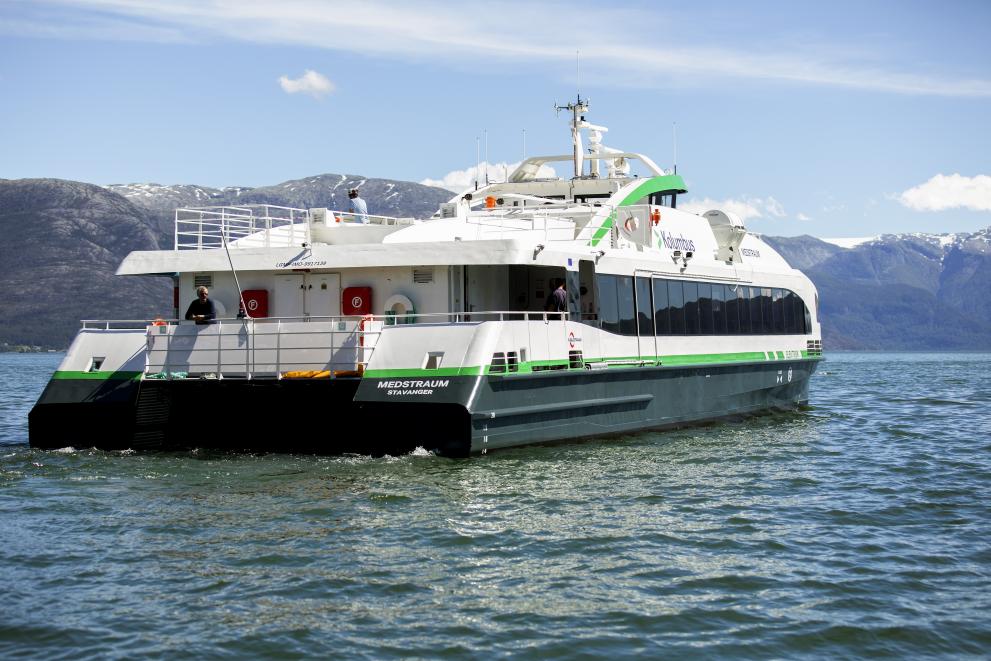
Shipping is an important part of the EU economy and contributes to coastal economies. But while it's an efficient mode of transport, it's still a major greenhouse gas emitter. Ships are among the world’s biggest polluters. To replace them means finding alternatives to traditional diesel engines. With climate change at the fore of the industry's mind, companies are testing the waters with game-changing solutions.
Passenger boats however need to go fast and can't rely on wind energy alone. In Stavanger, Norway’s “capital of oil”, ferry services are saying goodbye to fossil fuels.
Celebrated "Ship of the Year", Medstraum is the world’s first 100% electric high-speed ferry, and the demonstrator project vessel of the EU-backed TrAM (Transport: Advanced and Modular) project.
Ditching diesel engines for electric
Medstraum's batteries are safely arranged above the deck, powering two electric motors. The ship doesn't need to rely on fossil fuels as a backup. It’s also much smaller and more compact than a diesel engine.
Mikal Dahle, the TRAM Project Manager at Kolumbus who operates the Medstraum ferries hails the new technology’s potential.
“In total [it gives] us 1,500 kilowatt hours of energy. A typical electrical car would be between 70 and 90-kilowatt hours, so this is at least 15 times that in this vessel."
Fitted with two electrical engines and a battery with 1,5 MWh capacity, the vessel is designed for a service speed of 23 knots. The ferry can easily handle a 90-minute, multi-stop commuter route between Stavanger and the nearby islands. It carries 150 passengers and has space for bicycles, all while offering a smooth, noiseless, and sustainable ride.
Charging ahead to zero-emission operations
Dahle explains how they are expecting to greatly improve the company’s carbon footprint by cutting emissions by 1,500 tonnes per year just with this one ferry. That's the equivalent of taking 60 buses off the road!
"If we look at our CO2 emissions, they are dominated by some very few fast ferries. And being able to electrify these, and take away those emissions, is a significant part of becoming CO2 neutral in the next couple of years," says Dahle.
Medstraum runs about a dozen circular routes each day and plugs in for quick recharges between trips. And the best part is that all the electricity comes from renewable energy sources. So, this new fast ferry is setting the course for replacing smoke-polluting boats with a truly clean alternative.
This article was adapted from an original article published by Euronews on 21.12.2022
Find the documentary and article here
About the project
Whilst the vessel was launched earlier this year, the project has been long in the making. Partner discussions started back in 2016, and two years later 13 European partners were awarded funding from the EU's research and innovation programme, Horizon 2020.
Coordinated by Rogaland Fylkeskommune in Norway, the project set out to develop a concept for waterborne modular design and construction, with a focus on electric-powered vessels in protected waters and inland waterways. The aim is that the modular concept will work as a general purpose toolkit, enabling a wide set of vessel types to be built in a cost-efficient and environmentally friendly manner.
Construction began in spring 2021 at Fjellstrand Yard in Hardanger, Norway. At the naming ceremony earlier this year, Norwegian Minister of Transport, Jan-Ivar Nygård hailed the partner collaboration:
"Medstraum is a shining example of what we can achieve with good cooperation and innovation."
More
TrAM project website
TrAM project factsheet
Details
- Publication date
- 22 December 2022
- Author
- European Climate, Infrastructure and Environment Executive Agency
